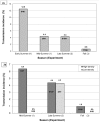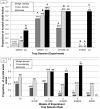Population density and seasonality effects on Sin Nombre virus transmission in North American deermice (Peromyscus maniculatus) in outdoor enclosures
- PMID: 22768034
- PMCID: PMC3387171
- DOI: 10.1371/journal.pone.0037254
Population density and seasonality effects on Sin Nombre virus transmission in North American deermice (Peromyscus maniculatus) in outdoor enclosures
Abstract
Surveys of wildlife host-pathogen systems often document clear seasonal variation in transmission; conclusions concerning the relationship between host population density and transmission vary. In the field, effects of seasonality and population density on natural disease cycles are challenging to measure independently, but laboratory experiments may poorly reflect what happens in nature. Outdoor manipulative experiments are an alternative that controls for some variables in a relatively natural environment. Using outdoor enclosures, we tested effects of North American deermouse (Peromyscus maniculatus) population density and season on transmission dynamics of Sin Nombre hantavirus. In early summer, mid-summer, late summer, and fall 2007-2008, predetermined numbers of infected and uninfected adult wild deermice were released into enclosures and trapped weekly or bi-weekly. We documented 18 transmission events and observed significant seasonal effects on transmission, wounding frequency, and host breeding condition. Apparent differences in transmission incidence or wounding frequency between high- and low-density treatments were not statistically significant. However, high host density was associated with a lower proportion of males with scrotal testes. Seasonality may have a stronger influence on disease transmission dynamics than host population density, and density effects cannot be considered independent of seasonality.
Conflict of interest statement
Figures




Similar articles
-
Transmission ecology of Sin Nombre hantavirus in naturally infected North American deermouse populations in outdoor enclosures.PLoS One. 2012;7(10):e47731. doi: 10.1371/journal.pone.0047731. Epub 2012 Oct 26. PLoS One. 2012. PMID: 23110096 Free PMC article.
-
Natural history of Sin Nombre virus infection in deer mice in urban parks in Oregon.J Wildl Dis. 2010 Apr;46(2):433-41. doi: 10.7589/0090-3558-46.2.433. J Wildl Dis. 2010. PMID: 20688636
-
Genetic relatedness of deer mice (Peromyscus maniculatus) infected with Sin Nombre virus.Vector Borne Zoonotic Dis. 2004 Summer;4(2):149-57. doi: 10.1089/1530366041210747. Vector Borne Zoonotic Dis. 2004. PMID: 15228816
-
Development and Characterization of a Sin Nombre Virus Transmission Model in Peromyscus maniculatus.Viruses. 2019 Feb 21;11(2):183. doi: 10.3390/v11020183. Viruses. 2019. PMID: 30795592 Free PMC article.
-
Hantavirus.Clin Lab Sci. 2003 Winter;16(1):39-42. Clin Lab Sci. 2003. PMID: 12587657 Review.
Cited by
-
Is species richness driving intra- and interspecific interactions and temporal activity overlap of a hantavirus host? An experimental test.PLoS One. 2017 Nov 15;12(11):e0188060. doi: 10.1371/journal.pone.0188060. eCollection 2017. PLoS One. 2017. PMID: 29141047 Free PMC article.
-
Transmission ecology of Sin Nombre hantavirus in naturally infected North American deermouse populations in outdoor enclosures.PLoS One. 2012;7(10):e47731. doi: 10.1371/journal.pone.0047731. Epub 2012 Oct 26. PLoS One. 2012. PMID: 23110096 Free PMC article.
-
Effect of seasonality on the population density of wetland aquatic insects: A case study of the Hawr Al Azim and Shadegan wetlands, Iran.Vet World. 2019;12(4):584-592. doi: 10.14202/vetworld.2019.584-592. Epub 2019 Apr 22. Vet World. 2019. PMID: 31190715 Free PMC article.
-
Landscape, Climate and Hantavirus Cardiopulmonary Syndrome Outbreaks.Ecohealth. 2017 Sep;14(3):614-629. doi: 10.1007/s10393-017-1255-8. Epub 2017 Jun 15. Ecohealth. 2017. PMID: 28620680 Review.
-
The Needs for Developing Experiments on Reservoirs in Hantavirus Research: Accomplishments, Challenges and Promises for the Future.Viruses. 2019 Jul 19;11(7):664. doi: 10.3390/v11070664. Viruses. 2019. PMID: 31331096 Free PMC article. Review.
References
-
- Anderson RM, May RM. Population biology of infectious diseases: Part I. Nature. 1979;280:361–367. - PubMed
-
- Dobson AP, Hudson PJ. Grenfell BT, Dobson AP, editors. Microparasites: Observed Patterns in Wildlife Populations. 1995. Ecology of infectious diseases in natural populations. Cambridge; New York: Cambridge University Press.
-
- Adler F, Pearce-Duvet J, Dearing M. How Host Population Dynamics Translate into Time-Lagged Prevalence: An Investigation of Sin Nombre Virus in Deer Mice. Bulletin of Mathematical Biology. 2008;70:236–252. - PubMed
-
- Sauvage F, Langlais M, Yoccoz NG, Pontier D. Modelling Hantavirus in Fluctuating Populations of Bank Voles: The Role of Indirect Transmission on Virus Persistence. Journal of Animal Ecology. 2003;72:1–13.
-
- Yin Z, Lam TJ, Sin YM. The effects of crowding stress on the non-specific immuneresponse in fancy carp (Cyprinus carpio L.). Fish & Shellfish Immunology. 1995;5:519–529.
Publication types
MeSH terms
Grants and funding
LinkOut - more resources
Full Text Sources

